What could be more stylish and romantic than a wedding in Paris? With the rise in popularity of destination weddings and the thriving hospitality industry that caters to them, Paris has become as viable a destination option to the newly engaged as a wedding on either coast of the United States. Unfortunately, alongside the fairytale images of a Parisian wedding is the harsh reality of miles and miles of administrative red tape.
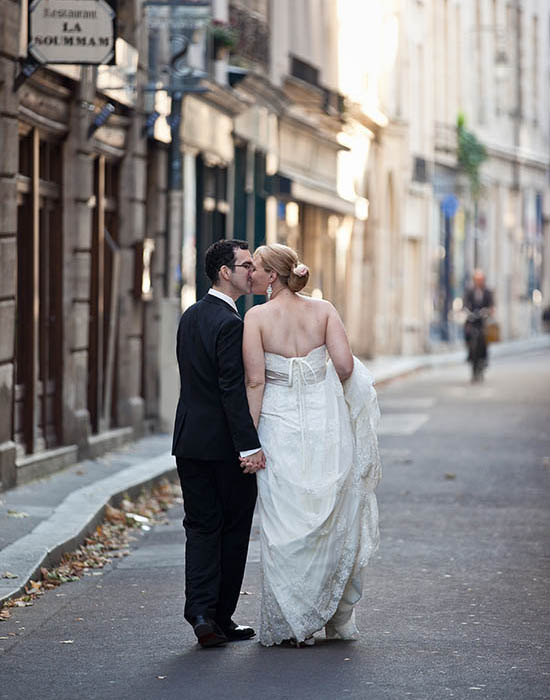
Photography by One and Only Photography.
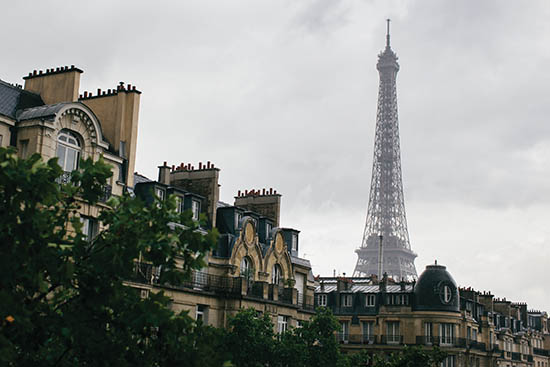
Photography by Ian Holmes.
One of the biggest obstacles for you love-struck couples who want to get married in Paris is that in order to be legally wed in France, at least one of you needs to have lived in France, in the district around the city hall in which you plan to get married, for a minimum of forty consecutive days before the wedding. This includes the additional ten days for the city hall to publish the banns —a public announcement that is put up in the city hall for ten days before your marriage that lists your names and your wedding date so that any estranged husbands or wives have one last chance to find you before you’re married off.
Before asking for that sabbatical from work, though, you should know that this one little detail is actually a pretty big one. In order to prove residency, you’ll need to show two separate official documents that show your French address (called a justificatif de domicile ) such as a gas or electricity bill, a rent receipt, a French social security insurance card or a car leasing agreement. And just in case you’ve got the bright idea to rent an apartment in Paris on a short-term lease in order to meet this legal requirement, you need to know that it could take several months before you receive some of those documents.
If you’re not able to rent your own apartment, another option is for you and/or your honey to move in with a friend or relative in your desired district, and have that person sign an attestation d’hébergement sur l’honneur . This is a statement swearing that you have been living in that person’s home, and that they take full responsibility for you if you happen to be an illegal truffle trafficker or something. There is a ton of small print attached to this document, including a huge fine and a short trip to the guillotine if it’s ever found out that you were not, in fact, living with them. Know that this is a pretty big favor that you’d be asking of someone.
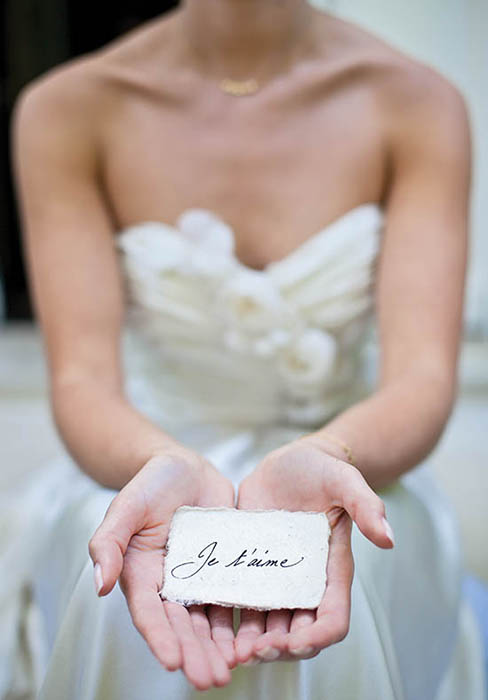
Photography by One and Only Photography (for www.monplusbeaujour.com.)
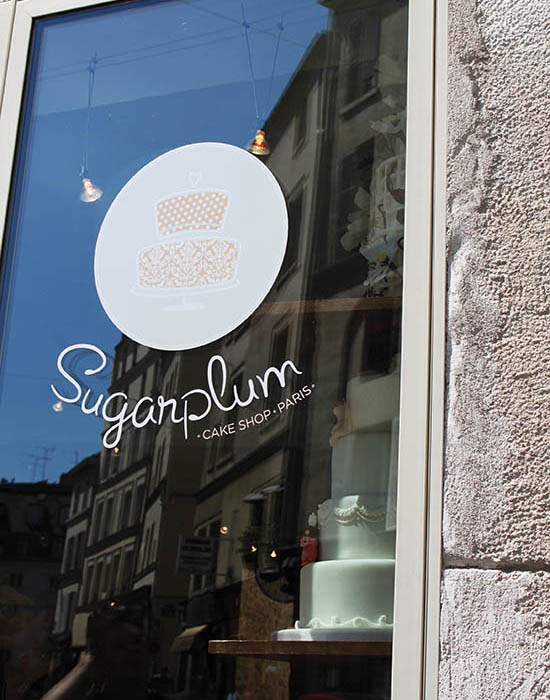
Photography by Clelia Naud.
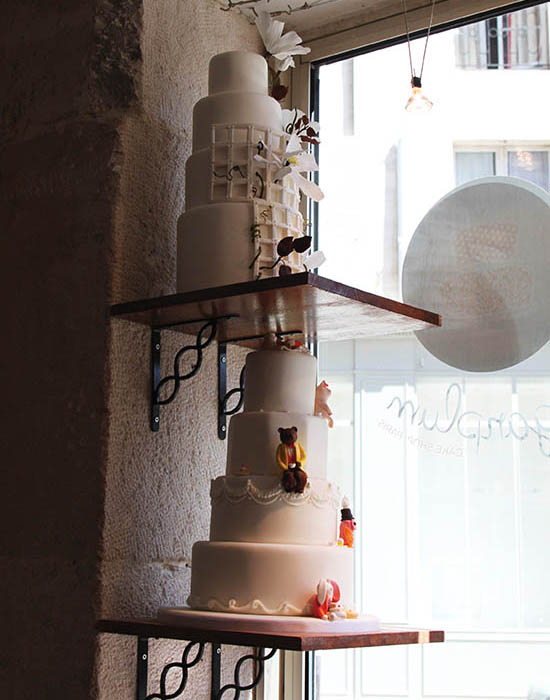
Photography by Clelia Naud.
If there’s one thing that you should learn early on about France and the French it’s that they love their paperwork. If you’re newly engaged, have decided to get married in Paris, and the forty-day residency issue is sorted out, the VERY first thing that you want to do is get the most recent list of required paperwork from the city hall ( mairie ) in which you plan to marry. Most of these documents have to be dated within specific time frames before being submitted, so it’s important to get the list as soon as you can. It’s important, though (and I can’t stress this enough), that you get the official, most up-to-date list from the specific city hall in the district ( arrondissement ) in which you are planning to marry. The lists are essentially the same, but there could be slight variations from district to district, so to be on the safe side, you should probably go to the source. Here’s a list of documents and information you’ll be required to have:
All of this needs to be presented, in person, to the mairie in time for them to check and approve your documents before posting the banns. They typically ask for your completed marriage file twenty days before their publication, but I usually suggest that my clients submit their file sooner than that, just in case there’s a document missing. When all has been accepted and approved, you’ll receive confirmation from the mairie of your wedding date (you can request a specific date and time when you drop off your paperwork, but they will assure you that nothing is confirmed until the dossier has been approved).
Keep in mind that you must be legally married in a civil ceremony before you will be allowed to have a religious ceremony in France. After your civil ceremony, you’ll receive a Livret de Famille —a velvet booklet that contains your marriage certificate. It also has LOTS of extra pages for you to keep track of your future children. This little blue book is the Holy Grail. If you live in France, this book will make your administrative life here a lot easier pretty much until the day you die (in which your death will be noted in said little blue book). If you don’t plan on staying in France, think of it as the ultimate wedding present.
Getting married in a foreign country is rarely easy. A Parisian wedding is just a bit more difficult than that. But if you are willing and able, the lasting memory of exchanging your vows beneath the shadow of the Eiffel Tower or in the cobbled halls of a centuries-old chateau is worth the few months of frustration.
| French Embassy United States |
| 4101 Reservoir Road, NW |
| Washington, D.C. 20007 |
| www.info-france-usa.org |
| www.ambafrance-us.org |
| French Consulates United States |
| The Lenox Building, Suite 500 |
| 3399 Peachtree Road |
| Atlanta, Georgia 30326 |
| www.consulfrance-atlanta.org |
| 88 Kearny Street, Suite 600 |
| San Francisco, California 94108 |
| www.consulfrance-sanfrancisco.org |
| 934 Fifth Avenue |
| New York, New York 10021 |
| www.consulfrance-newyork.org |
| French Embassy England |
| 58 Knightsbridge |
| London SW1X 7JT |
| www.ambafrance-uk.org |
| French Embassy Canada |
| 42 Promenade Sussex |
| Ottawa, Ontario K1M 2C9 |
| www.ambafrance-ca.org/ |
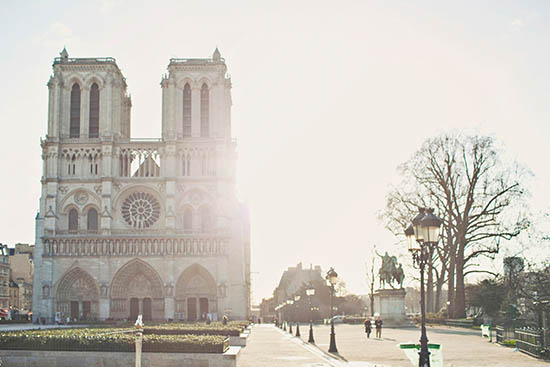
Photography by Heidi Gledhauser.
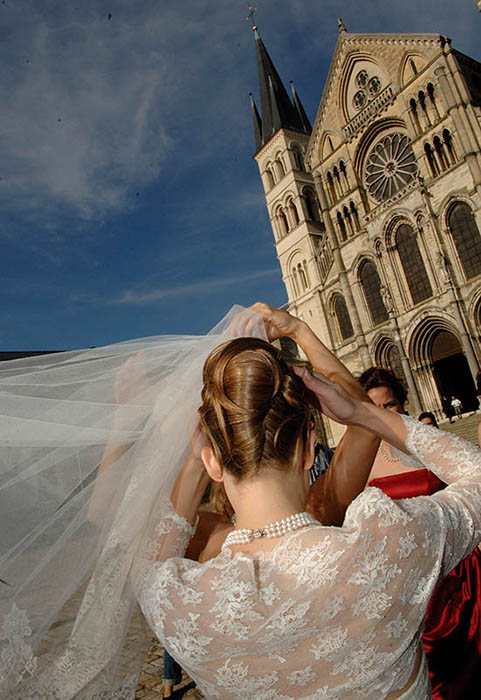
Photography by Arman Molavi.
How to Get Married in a Catholic Church in Paris
After “how can we get married on the Eiffel Tower,” I would have to say that my second most requested Paris wedding venue inquiry would be “we want to get married at Notre Dame Cathedral.” Unfortunately, unless you have friends or relatives in some extremely high places, it is next to impossible to marry in Notre Dame. I think it’s also worthwhile to mention here that, for a foreigner legally living outside of France, it isn’t exactly a cakewalk to get married in any church in Paris. One of the biggest things to keep in mind is that before a Catholic church in France will even consider marrying you, you must first have a civil ceremony either in France or in your home country. Once that is sorted, you should then put on your Sunday’s best, and get thee to the church in question for a little face-time.
The tricky part is that in order to get married in a church in France, you have to get direct permission from the priest of the church, and, quite frankly, he may not want to do it. Keep in mind that France is a traditional Catholic country, and parishes are pretty deep-rooted in their communities. You are asking to be accepted into the folds of a parish in order to take part in a holy rite. If the priest feels that you aren’t considerate of this, or feels that you’re trying to “buy” a place in their church (I can’t tell you how many American clients have contacted me asking for help after being denied permission to marry at a church after they’ve grossly waggled inch-thick stacks of fifties in the priest’s face); he has every right to say no. So I suggest that, if you’re able, you and your betrothed start going to the church for a while before you first meet with the priest— and make sure that he sees you. When you do have your first meeting with him, be as reverent and respectful as the meeting deserves, and be prepared to plead your case. I’ll just tell you now that nine times out of ten, the priest will “strongly suggest” that you marry in your own parish, all while walking you out the front door! So get your elevator pitch ready. Let him know how much France, Paris, and the arrondissement means to you, and why you must marry in his church. If you have any warm-n-fuzzy stories to tell (a grandparent or cousin who was married or buried in the church, for instance), be sure to get them in there. And, of course, a plate of killer homemade chocolate-chip cookies never hurt.
If you’re planning to marry in a church in Paris but aren’t currently in France, honestly, you have your work cut out for you. Your emails will more than likely go unanswered. If you try to phone the church directly, you will probably never make it past the church secretary. The best suggestion that I have is to find a friend or relative with strong, personal ties within that specific parish to make the plea on your behalf. This should be someone that you are on very good terms with, because it may require more than a few visits with the priest before you get your final answer.
And speaking of final answers, as anyone who has spent any time at all in France knows, the first answer is always “non.” Just ignore that one and ask again in a different way. If, after the fourth or fifth try, the answer is still no, then I would suggest you move on to Plan B, a symbolic ceremony in a private chapel or maybe a blessing ceremony in a non-denominational Parisian church.
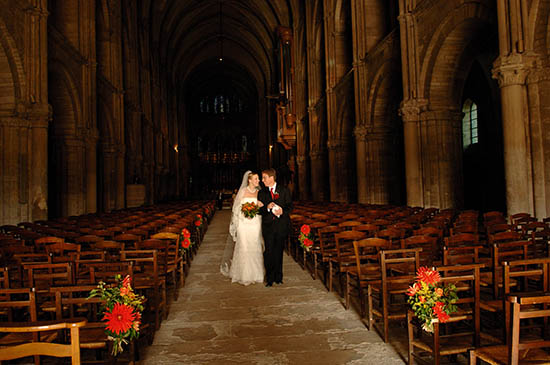
Photography by Arman Molavi.
If you’re lucky enough to have the right connections and are able to find a priest in France who agrees to perform your wedding ceremony in his church, you’ll find that you still have to get your paperwork in order. Ah, paperwork—France just wouldn’t be France without it. But no worries. Your American Wedding Planner in Paris comes through again! Here are the documents typically required to marry in a Catholic church in France. As with legal ceremony requirements, you must get the official list from your specific church in France, but here’s what you can expect:
All of the above documents need to be submitted to the priest of your French church at least two months before your wedding date in order to give you enough leeway in case there are any unforeseen hitches. As some of the documents are time sensitive, I typically suggest that you give yourself four to six months before your wedding date to start accumulating your documents. This is all after you have received confirmation directly from the priest that he will marry you in his church, of course.
Being married in one of the dozens of beautiful, historic churches of Paris is a chance of a lifetime. Although the process to get there may seem a bit daunting, the memory of your unforgettable Parisian celebration will make the journey worth it.
| Eglise Catholique en France |
| http://www.eglise.catholique.fr/ |
| The American Church in Paris |
| 65 quai d’Orsay |
| 75007 Paris |
| www.acparis.org/ |
.jpg)
Photography by One and Only Photography.
.jpg)
Photography by One and Only Photography.
.jpg)
French Weddings vs. American Weddings
My husband and I were once at a wedding in France when, around 11:30 p.m., just as dessert was being served, a couple showed up and sat down at our table. I assumed that they were just terribly late (or terribly rude), but after chatting with them for a bit, I realized that I had already spoken to them earlier that day after the ceremony at the church. Apparently, they had then mysteriously disappeared for the following five hours. I mentioned this to my husband, and he casually remarked, “Oh, they must have just been invited for the dessert.” Me: “Um, WHAT? ” Lui: “Yeah, Jean-Luc only works with Philippe, so they were probably invited just for the dessert.” Me (visibly taken aback): “And they came ?” Lui: “Ouf! You Americans are trop sensible (too sensitive)!”
And that, for me, is one of the biggest cultural differences between American and French weddings. A typical American wedding is made up of a ceremony (civil, religious or symbolic), a cocktail hour and a lunch or dinner reception followed by dancing. The entire event is usually over by midnight at the latest. When you’re invited to an American wedding, you’re either invited to the ceremony and reception, or, as is the case when the ceremony venue is very small, just the reception. A typical French wedding, on the other hand, lasts all day AND leads into the next. It starts with a civil ceremony at a city hall in the morning, is followed by a religious ceremony in a place of worship if the couple chooses, and then a vin d’honneur (small cocktail reception), and then a bigger cocktail reception, followed by a four- or five-course meal, and then finally, dancing. The dancing often starts between dinner courses in order to give guests a chance to work up more of an appetite! A typical French wedding doesn’t end until 3 or 4 a.m., or even later (there’s even an old French custom that is still practiced in some families today, where vats of French onion soup are brought out to the remaining guests at around 5 or 6 in the morning!).
Now, here’s the deal: Guests in France can be invited to all, or only part of a wedding’s festivities, even JUST dessert around midnight, and they don’t get offended by that! If you were to receive an invitation to a French wedding, it would probably say something like:
M et Mme LeFrancais
ont le bonheur de vous annoncer le mariage de leurs enfants
Paul et Virginie
et ont le plaisir de vous inviter au mariage civil
ainsi qu’à la bénédiction nuptiale qui auront leiu
le samedi 2 décembre 2013 à 15 heures
en l’église St Paul de Vence
A l’issue de la cérémonie, un vin d’honneur sera servi
à la salle paroissiale . . .
That’s saying that you’ve been invited to the civil ceremony, the church ceremony and the vin d’honneur immediately following the church ceremony in a small reception room at the church. In a typical French wedding, pretty much everyone is invited to the above. Okay, this is where it gets a bit funky: If you’re worthy, you will then have another card inserted into your invitation that says something like:
Paul, Virginie et leurs parents espèrent votre présence au diner
qui aura lieu vers 20 heures au restaurant LaDida.
Réponse souhaitée avant le xxx.
That means that you’ve been invited to the dinner, with dancing to follow. SCORE!
Or instead, you could receive a card that says something like:
M et Mme LeFrancais de vous recevoir pour le dessert,
le 2 decembre 2013, à partir de 23 heure, à la salle de Trucmuche
Which means that you’ve only been invited for dessert. Blam!
The reasoning is, of course, that everyone gets to participate in Paul and Virginie’s joyous day, and La Famille LeFrancais isn’t left with the financial burden of feeding the entire arrondissement. My hang-up is this: What if you thought you were a Level One, Cradle-to-the-Grave, Whole Enchilada-type of belle amie , but then, when you ripped open your invitation, OH SNAP—there was a cake card? What does that do to your friendship? How could you not be all frosty at the water-cooler the next time you see your “friend”? Wouldn’t you think twice before you tucked that 20€ bill into your Former Favorite Niece’s birthday card? How could you not spend the rest of the time before the wedding trying to dissect every conversation you’ve ever had in order to determine why you were “caked”?
I’m certainly not slamming French wedding etiquette. Like I said, French people don’t seem to mind this at all. Now that I think about it, maybe it’s not cultural at all. Maybe it’s just my own insecurities? If you were French, would you be offended (okay, slightly miffed) if you received an invitation to a wedding ceremony and dessert, but not to the dinner? Am I being “trop sensible”?
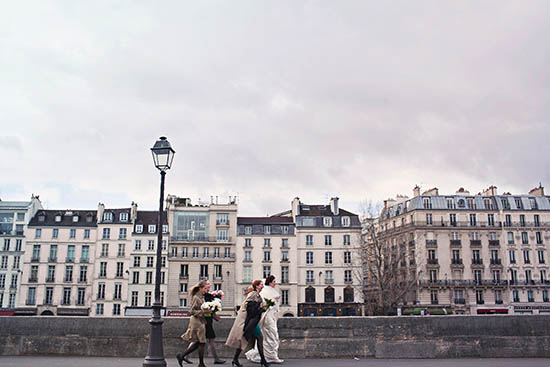
Photography by Heidi Gledhauser.
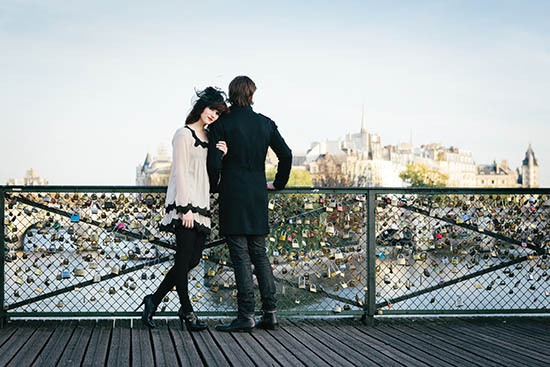
Photography by Ian Holmes.
The Best Places to Propose in Paris
As a wedding planner in Paris, I can’t tell you how many requests I get from panicked grooms-to-be looking for help on proposing to their bride-to-be at the top of the Eiffel Tower. One thing that I like to advise these guys is that a proposal, like amour, isn’t just about the payoff. One Pretty Spot + Four Little Words + Two Months Salary may = “oui,” but if in the end all she remembers is the bling, you’ve wasted a lot of time and energy! No, a truly unforgettable proposal requires a little foreplay. If you’ve decided to propose in Paris, you need to set the scene and completely immerse your future épouse (bride) in the sights, sounds and sentiments of Paris. Sure, the top of the Eiffel Tower is amazingly impressive, but wading through the endless lines of tourists and panhandlers to get there does tend to take a bit of the shine off.
With this in mind, I’ve compiled the American Wedding Planner in Paris’ Top Five Most Romantic Spots to Propose in Paris:
-
Ile de la Cité: The first spot on my list is the Ile de la Cité, the cradle of Parisian civilization, where the ancient Parisii tribe lived before the Romans conquered them in A.D. 57. If you’re bringing your sweetie all the way to Paris to propose, what could be more romantically symbolic than proposing at the very epicenter of Paris? With beautiful monuments like Notre Dame Cathedral, the Pont Neuf, the Conciergerie and Sainte-Chapelle, sprinkled with little parks, squares and markets, it’s one of the most romantic spots in Paris, with perfect “proposal ops” for both day and night.
-
Jardin du Palais Royal: This one is a more personal favorite. My French husband wooed me oh-so-many years ago with romantic walks through the Palais Royal. All of the elements of the perfect proposal are here.
A. Mystery and Intrigue: The gardens are hidden from the street on all sides by almost identical buildings. You’ll need a good map (or a little know-how) to find one of the doorways that enter onto the garden.
B. Peace and Quiet: The same walls keep the noise of the Parisian traffic out. If you’re lucky, there may be a cellist or opera singer performing beneath the tall arcades, but usually the loudest sound you’ll hear will be coming from the beautiful fountain in the center of the garden.
C. Romantic Ambiance: The arcades of the Palais Royal house cute little shops, restaurants and cafes—a perfect place to wander through, soaking up Parisian atmosphere before you stroll over to one of the benches that dot the park and ask for your honey’s hand in marriage . . .
-
Pont des Arts: How could she say no to a proposal on one of the most enchanting bridges in Paris? The Pont des Arts is a wooden pedestrian bridge, which leads to the Louvre and has the most amazing views of Paris (with the Eiffel Tower in the distance) and the Ile de la Cité. A little wine, a little baguette et fromage (bread and cheese), the sun setting on the Seine . . . and she’s yours for the asking! And while you’re there, don’t forget to leave a Love Lock as a memento of your Parisian adventure. People write their initials on a lock, attach it to the bridge, make a wish, then throw the key into the river. There are love locks all over the world. The one in Paris is at Pont des Arts.
-
Canal St. Martin: This charming, tree-lined waterway in the 10th arrondissement is still pretty much overlooked by tourists, especially in off-peak months. Built by Napoleon III in 1825 to transport materials from quarries in the north to the Seine, the waterway’s charming iron footbridges and locks are still standing, and set a romantic tone for a different type of wedding proposal. After checking out the “bohemian chic” shops and waterfront cafés along the Quais de Valmy and de Jenmapes, stroll on over to the Parc de la Villette and board a canal cruise. Take a tranquil two-hour ride down the canal and out onto the Seine, where you’ll have plenty of opportunities to pop the question.
-
Maison Blanche: Located on the top of an old Art Deco theater off the Champs-Elysées, Maison Blanche is a hip and trendy romantic restaurant where you go to see and be seen. Reserve a table near the windows if you want to impress her with a breathtaking panoramic view of Paris and the Eiffel Tower, or book one of the cozy booths if you want something a bit more intime (intimate) for the big moment.
If you’ve decided to propose in Paris, you need to set the scene and completely immerse your future bride in the sights, sounds and sentiments of Paris.
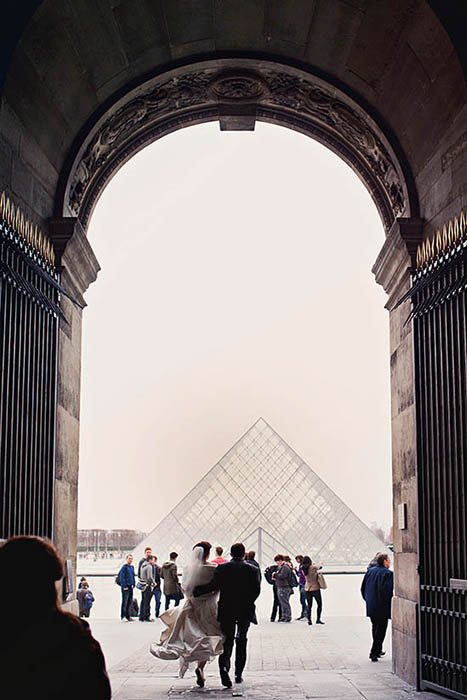
Photography by Heidi Gledhauser.
Top Five Tips for an Elopement or Vow-Renewal in Paris
There are tons of reasons why people choose to elope: to save money, to save time, to save their sanity! Couples who contact me about eloping in Paris also typically display a very strong romantic streak. Since I find myself answering a lot of the same questions week after week, and since the answers can easily apply to couples wanting to renew their vows as well, I’ve decided to compile the American Wedding Planner in Paris’ Top Five Tips for Planning an Elopement or Vow-Renewal in Paris.
-
Start Planning Early: Be aware that there aren’t many English-speaking celebrants available in Paris, and most of them work full time at their own churches, which leaves a limited amount of time to officiate weddings for couples coming from overseas. To be fair, you should plan on contacting a celebrant at least three months in advance of your ceremony (longer if you’re planning on eloping during the high season).
-
Hire a Good Wedding Planner: This one is pretty simple. A destination wedding is a destination wedding, whether it’s just you two or two hundred of your closest friends! Besides having access to top-notch local vendors, hiring a wedding planner based in the destination that you’re planning your elopement takes the pressure off you and your honey, and gives you time to concentrate on planning your honeymoon. As when you’re hiring your officiant, keep in mind that most wedding planners need at least three months notice to book an elopement ceremony.
-
Try Not to Plan Too Much: So, my first pointer was to start planning early, but that’s not to say to plan every single second of your event! Remember, France runs at its own pace, and to most Americans, that’s about three and a half paces behind the United States! I’ve had elopement clients send me their itineraries timed to the quarter hour, “Car Pick-Up at Hotel: 12:45. Arrive at Eiffel Tower: 1:05. Waiter brings first glass of champagne: 2:17, etc. etc.” If you learn nothing else from this book, learn this: You can pay a deposit, fax an Excel spreadsheet, confirm, and re-confirm an order, but it won’t really confirm anything. In Paris, “on time” typically means between fifteen and thirty-five minutes “late” by U.S. standards. So, just know that it will all work out in the end, and the wedding ceremony will be just as lovely twenty minutes “later” than planned.
-
You Cannot Get Married on Top of the Eiffel Tower: Let me just say that once again for the girls at the back: You Can NOT get married on top of the Eiffel Tower! The Eiffel Tower is a national monument. Occasionally, the top is rented out for corporate functions, but not to private individuals. If you want to host a small, personal event at the Eiffel Tower, you’ll be encouraged to rent private rooms at one of the two restaurants in the tower.
-
Think Off the Beaten Path: If you’ve already decided to elope to Paris, chances are you’re a pretty non-traditional couple. So why settle for the “same-old same-old” once you’ve arrived in Paris? Sure, you can get married beneath the Eiffel Tower. It’s gorgeous, historical, romantic—everything that you could ask from a wedding in Paris. But wouldn’t it be really cool to exchange your vows on top of the Parc des Buttes Chaumont, with its amazing panoramic view of the city spread out at your feet? Or even at sundown in the dramatic shadows of the Pyramide du Louvre? Since you’re creating your own unique elopement ceremony, the world (or at least Paris) is your oyster! Elopement ceremonies tend to be fairly short, so if you’re mindful of the legalities of your intended venue (no standing on the grass, for example, if you’re not permitted to do so), and respectful of your environment (e.g., don’t hire an accordionist to serenade you in a busy restaurant), your elopement in Paris should go off without a hitch!
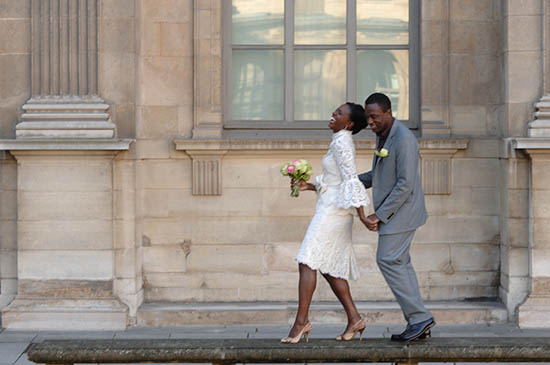
Photography by Arman Molavi.
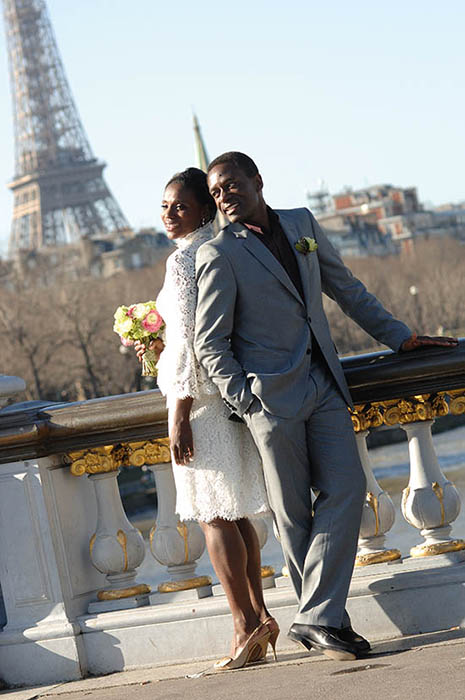
Photography by Arman Molavi.
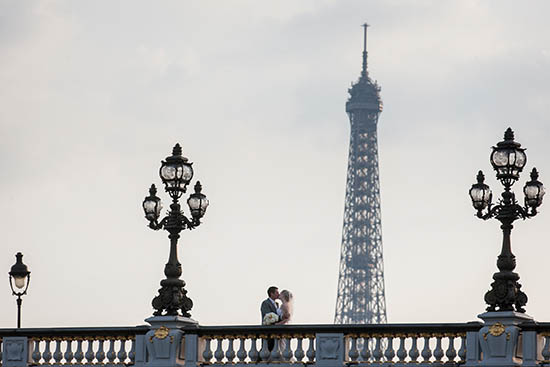
Photography by Ian Holmes.
What to Wear to a Wedding in Paris
You’ve just received an invitation to your first French wedding. Your initial thought (“How exciting!”) is quickly replaced by, “OMG, what am I going to wear?” Fear not, your American Wedding Planner in Paris is here to guide you. First, you should know that people in France don’t typically tend to dress up for weddings as much as they do in the States. At Franco-American weddings, you can always pick out the American guests by their clothes and their smiles. I, personally, find this absolutely refreshing, I mean, if you can’t dress up for a wedding, when can you dress up? This isn’t to say that the French never dress for weddings. It’s just that sometimes the look tends to be more Casual Friday than Friday Night Swanky. If the wedding is between families of a certain background, of course, you will dress up. Unfortunately, in many destination wedding situations you only know one-half of the couple, and don’t know anything about his or her family’s background.
So how do you decide what to wear? The most obvious clue is the invitation. Is it a classic cream or ivory card stock with formal text and titles? Or is it a more contemporary design, with a touch of color and modern text? A formal invitation doesn’t always mean a formal wedding, but it’s a pretty good clue.
The second hint is the address of the city hall, church and/or reception. Like most places, there are tonier sides and less tonier sides of every town in France. If the wedding is in Paris, and is being held in the mairie and church in the 16th arrondissement with the reception at the Hotel Crillon, it’s safe to say that you should dress up. If the civil ceremony takes place in the city hall of the 13th arrondissement, with no church ceremony but a reception dinner cruise on the Seine, then you will probably be more comfortable in a more casual outfit.
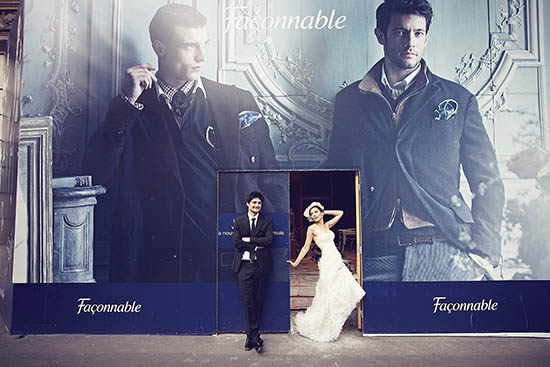
Photography by Milos and Natasa Horvat.
One important bit of information to know is that when you’re shopping for your French wedding outfit, you’re actually shopping for two outfits! Like I’ve mentioned before, French weddings last all day long, and most guests will change outfits sometime between the morning ceremony and evening reception, with the evening look typically more casual than the morning’s. Again, look to the location of the venue to help you with this.
So, just how “dressy” and how “casual” is acceptable at a French wedding? For a standard formal French wedding ceremony, think “Four Weddings and a Funeral,” but a little less “British madness” with the hat. A beautiful day suit or ensemble by Catherine Varnier, for example, with or without a stylish chapeau should do the trick. Try Les Chapeaux de Béa in Paris for a gorgeous selection of wedding hats. For a more casual wedding, a chic and classic look by Tara Jarmon paired with trendy bold accessories should help you fit right in with the rest of the Parisian invités (guests).
If you plan to attend the religious ceremony, be aware that it is a respectful gesture for women to cover their shoulders in church. So if you choose a sleeveless number, be sure to bring a jacket or pashmina with you for the ceremony. Also, in France, as in the United States, it is typically interdit (forbidden) for any woman other than the bride to wear white.
Many French wedding magazines and websites will have sections devoted to clothes and accessories for the wedding guests. Called tenues d’invités in French. Check out www.Madame.LeFigaro.fr for a great list that is updated often.
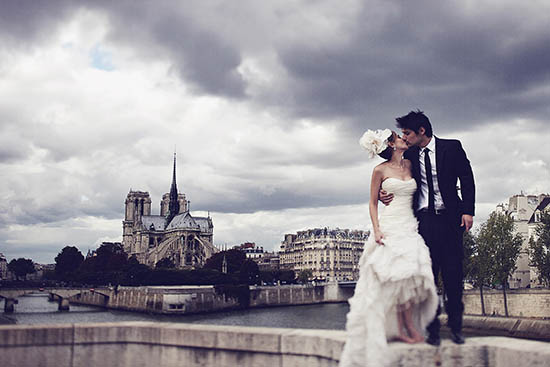
Photography by Milos and Natasa Horvat.
With French weddings lasting all day and into the next morning, many guests will change outfits sometime between the morning ceremony and evening reception.
| Catherine Varnier |
| 48, rue d’Assas |
| 75006 Paris |
| 01 42 84 15 12 |
| www.catherine-varnier.com |
| Tara Jarmon |
| 73, avenue Champs-Elysées 75008 |
| www.tarajarmon.com |
| Les Chapeaux de Béa |
| www.leschapeauxdebea.com |
Melissa & Michael
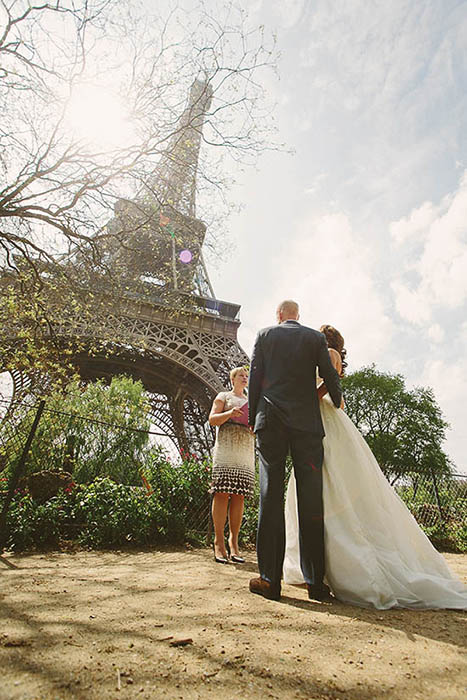
Photography by Milos and Natasa Horvat.
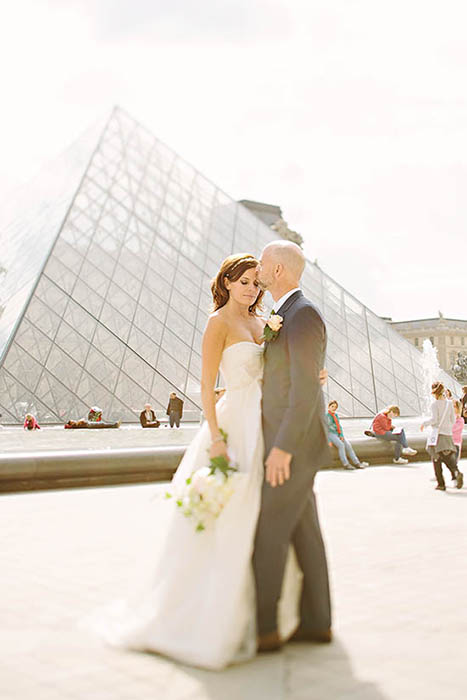
Photography by Milos and Natasa Horvat.
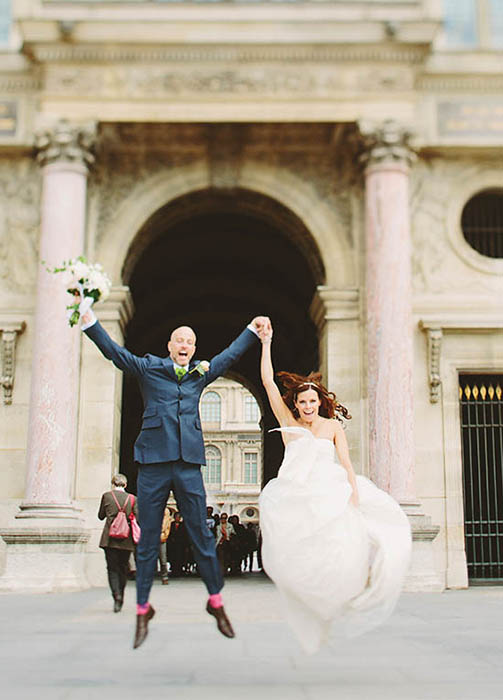
Photography by Milos and Natasa Horvat.
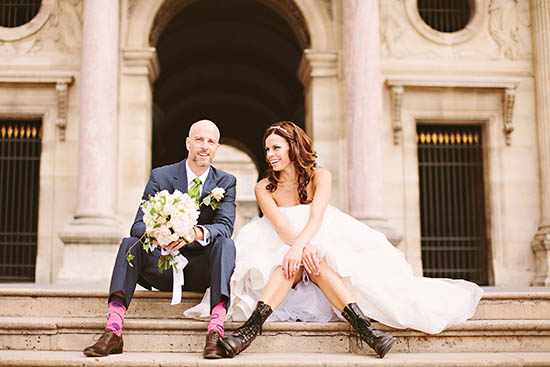
Photography by Milos and Natasa Horvat.
Paris is brimming with hundreds of breathtaking, romantic locations. Why not consider exchanging vows beneath the echoing, vaulted ceilings of the Place des Vosges?
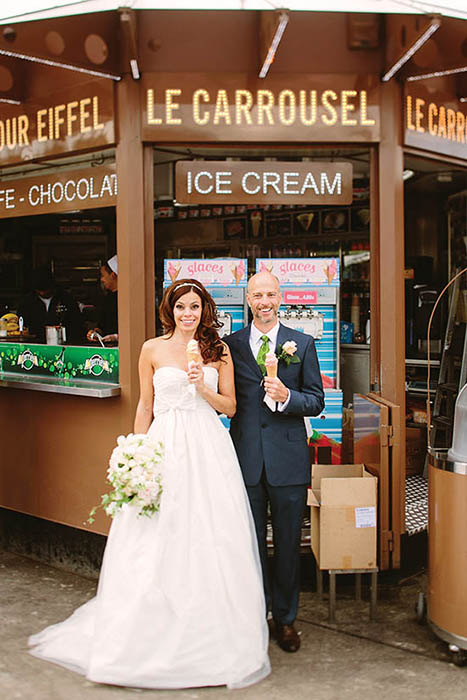
Photography by Milos and Natasa Horvat.
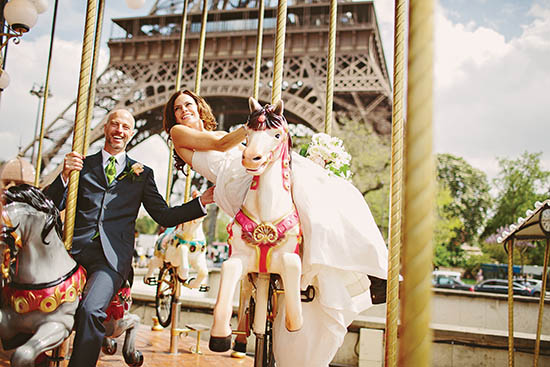
Photography by Milos and Natasa Horvat.
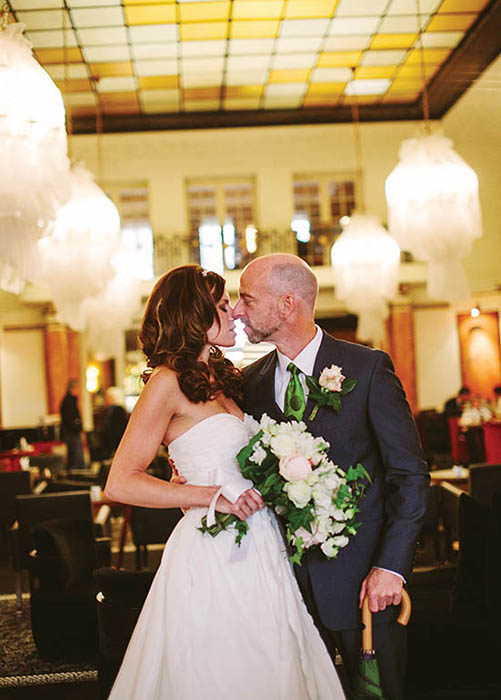
Photography by Milos and Natasa Horvat.
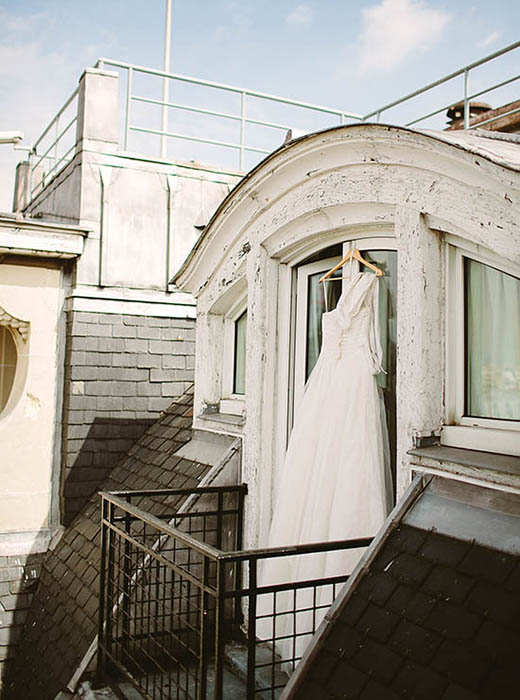
Photography by Milos and Natasa Horvat.
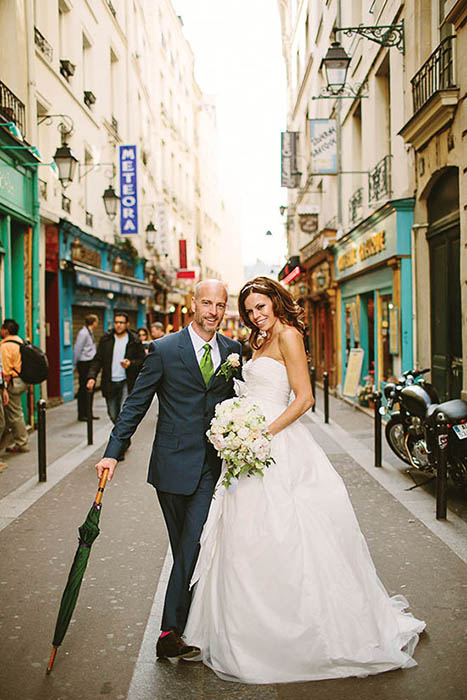
For their Parisian elopement, Melissa and Michael wanted to not only celebrate their marriage, but they also wanted to celebrate Paris—in all of its stylish glory. So we organized a whirlwind, citywide photo session following their intimate ceremony at the base of the Eiffel Tower. It was chic and simple, with a hearty helping of Parisian glamour.
Photography by Milos and Natasa Horvat.
| Wedding Design and Coordination |
| Kim Petyt, Parisian Events |
| www.parisianevents.com |
| Photography |
| Milos and Natasa Horvat |
| www.miloshorvat.com |
| Hair and Makeup |
| James |
| www.jmsbyjames.com |
| Dress |
| White by Vera Wang |
| Boots |
| Ralph Lauren Paris |
| vintage army issue |
| Hair Accessory |
| Tessa Kim |
| www.tessakim.com |
| Groom |
| Paul Smith from head to toe; |
| suit, shirt, tie, cufflinks, socks, |
| shoes and belt |
| Wedding Bands |
| Alan Friedman of Beverly Hills |
| www.alandiamonds.com |